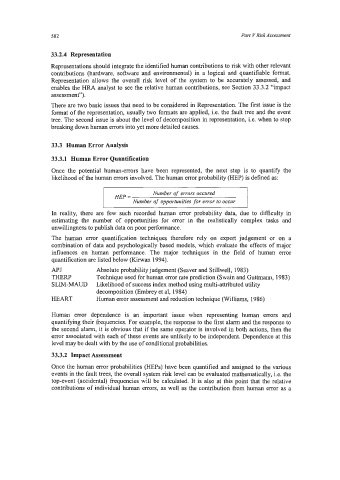Page 606 - Marine Structural Design
P. 606
582 Pari V Risk Assessment
33.2.4 Representation
Representations should integrate the identified human contributions to risk with other relevant
contributions (hardware, software and environmental) in a logical and quantifiable format.
Representation allows the overall risk level of the system to be accurately assessed, and
enables the HR4 analyst to see the relative human contributions, see Section 33.3.2 “impact
assessment”).
There are two basic issues that need to be considered in Representation. The first issue is the
format of the representation, usually two formats are applied, i.e. the fault tree and the event
tree. The second issue is about the level of decomposition in representation, i.e. when to stop
breaking down human errors into yet more detailed causes.
33.3 Human Error Analysis
33.3.1 Human Error Quantification
Once the potential human-errors have been represented, the next step is to quantify the
likelihood of the human errors involved. The human error probability (HEP) is defined as:
Number of errors occured -1
HEP =
Number of opportunities for error to occur
~
In reality, there are few such recorded human error probability data, due to difficulty in
estimating the number of opportunities for error in the realistically complex tasks and
unwillingness to publish data on poor performance.
The human error quantification techniques therefore rely on expert judgement or on a
combination of data and psychologically based models, which evaluate the effects of major
influences on human performance. The major techniques in the field of human error
quantification are listed below (Kirwan 1994).
APJ Absolute probability judgement (Seaver and Stillwell, 1983)
THEW Technique used for human error rate prediction (Swain and Guttmann, 1983)
SLIM-MAUD Likelihood of success index method using multi-attributed utility
decomposition (Embrey et al, 1984)
HEART Human error assessment and reduction technique (Williams, 1986)
Human error dependence is an important issue when representing human errors and
quantifying their frequencies. For example, the response to the first alarm and the response to
the second alarm, it is obvious that if the same operator is involved in both actions, then the
error associated with each of these events are unlikely to be independent. Dependence at this
level may be dealt with by the use of conditional probabilities.
33.3.2 Impact Assessment
Once the human error probabilities (HEPs) have been quantified and assigned to the various
events in the fault trees, the overall system risk level can be evaluated mathematically, i.e. the
top-event (accidental) frequencies will be calculated. It is also at this point that the relative
contributions of individual human errors, as well as the contribution from human error as a

